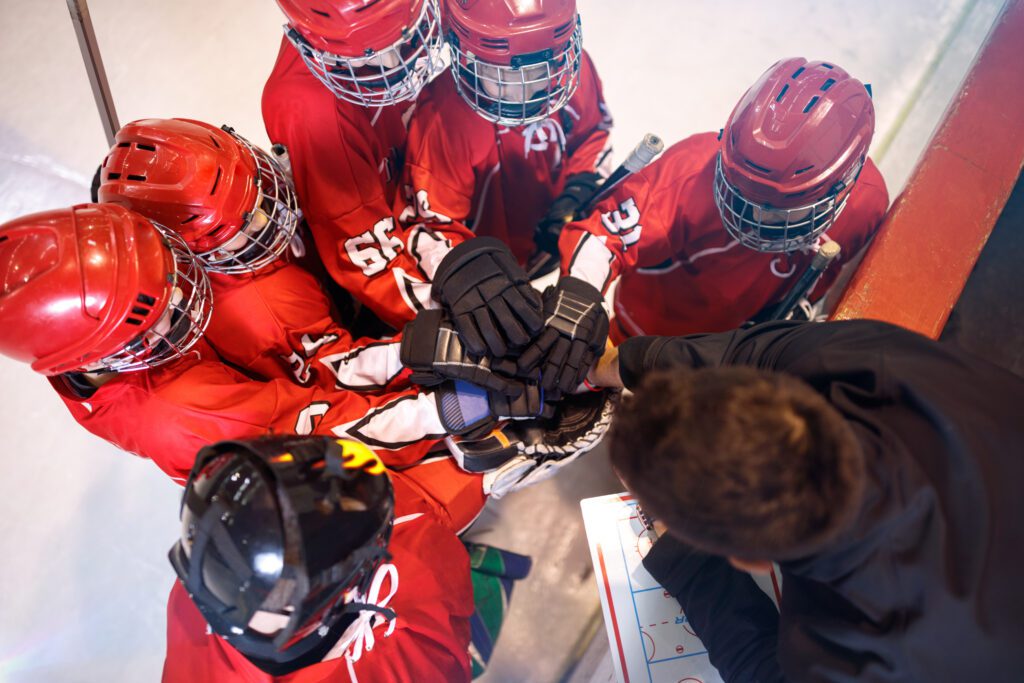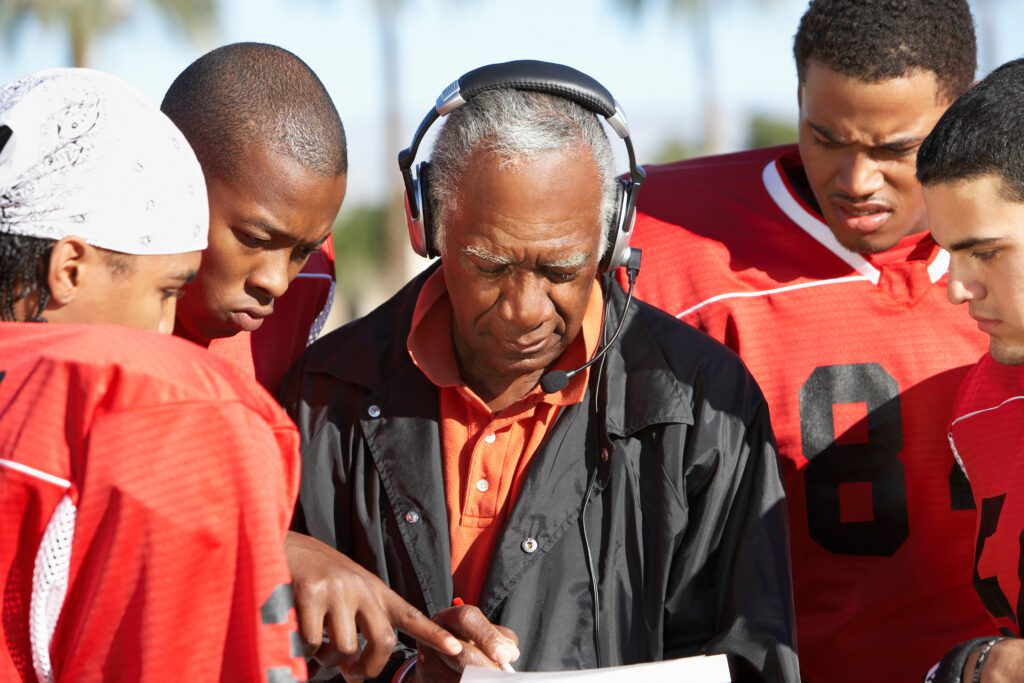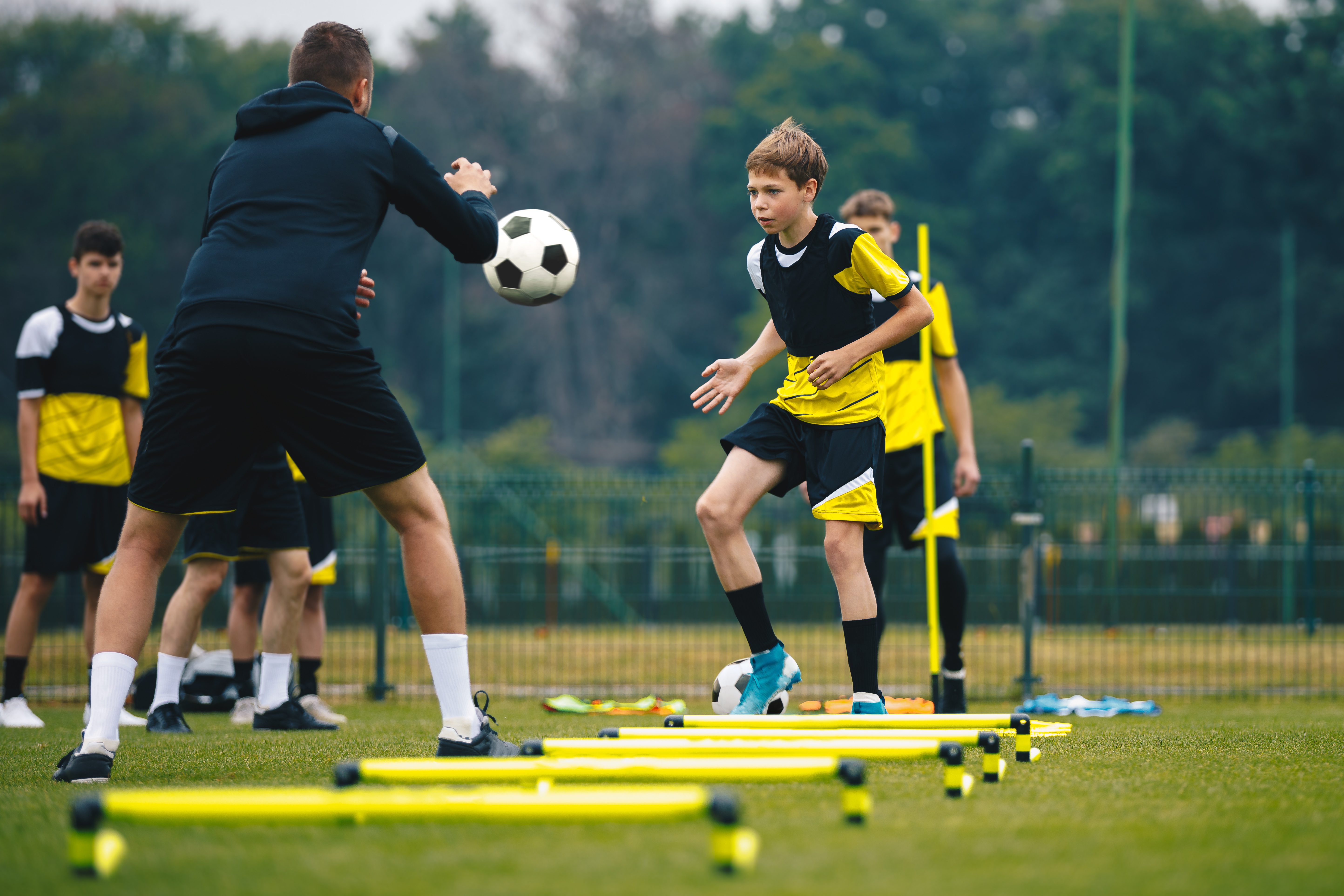
You run a high-energy drill. You repeat an instruction, again. You urge the team to reset and refocus but nothing’s clicking. You’re left wondering: Why aren’t they getting it? These moments are invitations to pause and reflect on how you’re connecting. Beneath the surface of performance lies a deeper influence on sport outcomes: Emotional Intelligence (EI).
EI is a cornerstone of effective coaching and athlete development (Jowett, Wachsmuth, Boardley, & Balduck, 2024; Orellana, 2023). EI fuels trust, motivation, engagement, and resilience. It’s foundational. It helps you coach beyond skills and reach athletes as people. When you coach with EI, you’re shaping performance and character skills that outlast the season. Think back to your own sports experience. You may recall coaches who left you feeling anxious and those who made you feel capable and energized. The difference was connection.
EI is the force behind how we show up under pressure and in the everyday. It helps coaches know when to push and when to pause. It builds a team culture where athletes thrive, not just perform. (Orellana, 2023). And far from softening competitiveness, EI sharpens it.
The gateway of self-awareness
EI starts with self-awareness: recognizing your emotions, triggers, and their impact on others. Coaches who regulate themselves model calm under pressure, creating safer psychological spaces and trust on teams.
High-pressure moments are when EI skills show up most clearly. Coaches who stay grounded, rather than suppressing emotions and/or reacting explosively model how to feel without losing focus or derailing performance. Coaches who are inconsistent, like being calm one moment, explosive the next, erode psychological safety. Athletes become guarded, fearing emotional whiplash.

Youth are sensitive to unpredictable authority figures, and trust can easily be broken. Emotionally steady coaches create stable, constructive environments that enhance athlete focus, reduce anxiety, and support healthier emotional expression (Thelwell, Lane, Weston, 2010). Coaches who model self-control turn tense moments into teachable ones.
- BENEFIT: Athletes experience less anxiety, take more risks, learn faster, and respond better to feedback.
Levelling the playing field
EI coaching is a two-way street where coaches learn as they lead and teach. Davis et al. (2019) found that emotionally open coaches boost athlete well-being and engagement. This openness creates opportunities for growth for both coaches and athletes.
Emotions are contagious. When coaches lead with calmness and clarity, athletes mirror that confidence. Self-awareness creates the space to respond and not just react. But unchecked tension can erode trust and shut down communication. A self-aware coach notices rising frustration and models integrity, perspective-taking, and emotional composure.
- BENEFIT: This builds environments where athletes feel safe enough to take risks and resilient enough to grow through failure.
TIP: Use post-practice debriefs to ask meaning-making questions
- What did you notice about yourself today?
- What challenged you emotionally?
- What did you learn from your mistakes?
- What do you feel you are on the verge of mastering in the game and in yourself?
A window to blind spots
Young athletes often look to coaches to help make sense of their own emotions. And if feedback feels off or dismissive, they shut down. Coaches who are emotionally attuned help athletes name and manage what’s going on inside which build not only connection but resilience. Stephenson and Jowett (2020) echo this: EI coaches build stronger bonds. Athletes feel seen, which boost both well-being and performance.

“Young athletes don’t know themselves as well as they could. They can sometimes be driven by ego. This can prevent them from being able to face challenges and conflict in healthy ways. It also impacts teamwork. We don’t create a space to acknowledge emotions or get to know individual players much in sports. If coaches understood players more, they would know how to approach them in different situations and be able to support their development more. This would then open players up to share things that are on their mind.”” – Former U18 AAA Hockey Player
Research shows athletes respond better to coaches who show empathy and adapt communication styles (Lorimer & Jowett, 2009). These coaches listen, read emotional cues, and adjust their response based on personality.
- BENEFIT: Coaches, gain deeper insight and trust that can inform and improve their coaching impact.
TIP: Use the 1–10 Scale
To check-in emotionally without putting athletes on the spot, try using a scale. It lets them respond without the need to explain. The acknowledgement alone can release tension while opening up new pathways to communication. Try questions like:
- On a scale of 1–10, how supported do you feel right now?
- How connected do you feel to the team?
- How strong is our coach-athlete relationship?
This can open the door to honest dialogue and reveal coaching blind spots. You can also ask them to think about:
- What would take your performance/our coaching relationship/our team up a notch?
- What do you need from me to help you with this situation/breakthrough?
- BENEFIT: It can reveal unmet needs and new strategies to support athlete growth and a stronger coaching relationship.
Coaching into the discomfort
EI coaching takes vulnerability as it means owning mistakes and raising the profile of soft skills as power skills on your team. When coaches build this muscle, they model authenticity and emotional courage. Authentic coaches embody self-awareness, self-regulation, and consistency (Avolio & Gardner, 2005).
Research on growth mindset shows that when leaders acknowledge effort and failure, they foster trust and perseverance. Coaches who say things like “You taught me something today” or “That landed differently than I intended” reflect emotional maturity and the mutuality of learning, which aligns with growth-oriented leadership. (Dweck, C. S. (2006 Mindset: The new psychology of success. Random House)
TIP: Model Building Your Vulnerability Muscle
- Even small moments of humility like “I’m still learning how to best support you” or “I’m still figuring this out” build trust and encourage athletes to own mistakes and grow from them too.
- BENEFIT: Teams perform better under pressure, adapt more quickly, and are more open to feedback.
Start with values
Great teams and organizations leverage a common set of values as driver of culture and performance. Values provide a strong foundation for enhancing EI. Grounding your coaching practice in values creates clarity in challenging situations or when we aren’t sure how to respond. They help us show up as our best selves despite what is going on around us.
Values give us access to the unspoken why behind our actions. They provide a common centreline to come back to in challenging and ambiguous situations which unites the team.
TIP: Bring Values to Life
Consider co-creating a “team values inventory” at the start of each season. These conversations help athletes connect effort with purpose and performance with growth. Ask:
- What values matter most to us?
- How do we live them with each other on and off the field – and in our daily lives?
- Where are we falling short?
- Which values are easier for you to embody and practice? How can you be a leader on the team in promoting that value?
- Which values are more difficult? Why is that? What step can you take to bring it to life more fully in yourself or the team?
- Find ways to use them as a compass and not just a slogan:
- Return to team values in moments of conflict or celebration.
- Name the value you see in action in athlete behaviour.
- Make them visible in team apps or the locker room.
- BENEFIT: Fosters resilience, empathy, loyalty, teamwork, moral development, responsibility, and motivation.
The muscle of reflection
Reflection is an easy way to build self-awareness and ignite the coach within in both coaches and athletes. Whether as a personal practice or a team exercise, it helps uncover blind spots, strengthen alignment to others, and keep ego in check.
TIP: Pair reflection with skill-building
Want to create a catalyst for growth? Add a weekly reflection practice for yourself and your team:
- What values guided my coaching/teamwork/performance this week?
- When have I acted in or out of alignment – and why?
- What impact am I having on others?
- What role did I play in a recent situation or conflict? What values can bring me back to my centreline?
- BENEFIT: Builds accountability, emotional maturity, and resilience.
Summary of Key Benefits of EI in Coaching
| EI Skill | Coaching Benefit | Athlete Performance Impact |
| Emotional regulation | Calm, clear-headed leadership | Lower stress, better focus |
| Feedback awareness | Tailored, motivating feedback | Greater learning and retention |
| Relational attunement | Stronger connection with athletes | Stronger trust and engagement |
| Values alignment | Ethical, consistent behaviour | Moral growth and respect |
| Reflective practice | Ability to learn and adapt | Optimize mindset and resilience |
Leveraging the language of Captain and Poet
Captains & Poets is a powerful EI coaching framework that helps athletes and coaches deepen self-awareness and lead with balance. It encourages coaches to integrate emotional insight into their practice, blending drive with compassion, and to coach authentically from the inside out to foster resilience, connection, and a values-driven team culture.


The model heightens self-awareness by helping athletes and coaches to understand two key parts of themselves:
- The Captain represents the drive to act, organize, focus, persevere, make decisions, take steps toward our goals, and get us out of our comfort zone and fuel our confidence.
- The Poet embodies our emotions, values, vison, creativity, passion, gut instincts, moral compass, and drive to connect.
Together, they create balance. The Captain gives the Poet courage to show up authentically; the Poet guides the Captain with purpose. This shared language helps coaches and athletes strengthen self-awareness, foster understanding, and build team culture and performance.
Good coaches know that when we can name something, we can begin to work with it. The Captain and Poet lens gives athletes the language to:
- Balance ego with authenticity
- Manage emotional challenges with compassion
- Express empathy and read teammates better
- Access inner resources during adversity
- Align with team dynamics more skillfully
This language brings EI to life, helping teams build stronger relationships to themselves and others. The video below gives a glimpse of the language in action. View the full video here.
Coaching the whole person
Too often, sports overemphasize the Captain: the driver, the competitor. While grit and focus are critical, neglecting the Poet limits long-term development, mental well-being, and our ability to bring our full selves to the team.
Great coaches understand that the doing follows the being. Our inner state dictates performance. When we lead from Poet we bring wisdom to our Captain’s actions.
When you want to rally the team after a critical mistake, your Poet reminds you to acknowledge their frustration and disappointment first. That balance helps you say the right thing at the right time which fosters connection and trust. We are all in this together.
Authentic coaching
Each athlete and coach have a unique combination of Captain and Poet traits that help us identify our unique abilities as well as our lens on the game, and the world. For example:
- The observant Poet and decisive Captain: a strategic goalkeeper
- The value-driven Poet and ambitious Captain: a motivating team leader
- The intuitive Poet and risk-taking Captain: a great playmaker
- The empathetic Poet and enthusiastic Captain: a champion for others
Understanding and embracing the mix of Captain and Poet traits on a team identifies untapped leadership on the bench and creates space for athletes to explore their full potential. It also enables coaches to know when to pivot (e.g., from a directive Captain to reflective Poet) and how to coach individuals and the team with more precision. It provides a deeper hook to turn things around in critical moments.
When coaches show up authentically, with their Captain and Poet in balanced leadership, they model self-leadership for athletes and set the tone on team culture in a natural way. It enables coaches to make the most of team talent by raising the profile of the value-driven Poet who contributes to team culture, and the empathetic Poet who supports teammates with a glance or a pat on the back, the observant Poet.

They can begin to see the unique Captain and Poet in athletes and pivot theirs to connect and communicate more effectively. The reflective Poet may need until next practice to apply your feedback. The risk-taking Captain may need coaching on how to channel that energy when you need to stick to rehearsed plays in a critical moment.
And when teammates understanding the interplay between their Captain and Poet and that of those around them, they can lead and collaborate more effectively. Skill, character, courage, and connection are ignited in subtle ways.
The coach within
Most coaches were shaped by traditional, results-driven methods. Identifying their own innate, authentic Captain and Poet traits can unlock new levels of connection, leadership, energy, and impact in coaching. A heart-centred Poet and ambitious Captain will be reminded of why they are coaching and bring that to the forefront. A values-driven Poet and goal-oriented Captain will inspire deeper cohesion and motivation.

As coaches strengthen their own authentic coaching style it ignites self-leadership in athletes which makes for a more aligned team. Coaching becomes more than skill transfer – it becomes a journey of self-awareness and shared growth. When coaches lead this way, athletes mirror the balance. The Captain and Poet become an integral part of team culture.
Authentic coaches use their Captain to show up with integrity and consistency, and their Poet to stay grounded in values and purpose. This shows up in real ways:
- Praising character, not just skill: “I saw how your Captain showed up when you set an example for everyone today.” “I heard your Poet today when you encouraged your teammate on the bench.”
- Celebrating grit (Captain) while making space for emotions after a tough game (Poet)
- Giving clear direction (Captain) and asking thoughtful questions (Poet)
- Coaching decisively (Captain) and debriefing with compassion after high-pressure moments (Poet)
It also gives coaches and athletes access to a broader repertoire of traits and approaches. They can ask, who does my Captain or Poet need to be right now in the moment? With deliberate practice and reflection, athletes and coaches can sharpen self-awareness and build stronger team culture together.
The EI playbook
Developing EI can feel daunting. It’s a lifelong journey and not something we “master” like technical drills. And textbook strategies alone won’t cut it. True EI emerges in the real-time interplay between coaches and athletes. It has to be authentic to be effective. When we:
- are in touch with our emotions, we can express them wisely and understand the emotions of others – and use them to fuel performance.
- know what is important to us, we can manage the things that trigger us in the moment. Being in touch with our values helps us to set meaningful goals and establish a clear “why” that inspires those around us through challenges.
- acknowledge our blind spots, we model vulnerability and return to our centre line with greater ease.
- know who we are, we can coach from our best, most authentic self. As we deepen our connection to ourselves, we naturally deepen our connection with those around us.
It’s the start of a new season in sport. Find your starting point and play to your strengths.
To learn more about the Captain and Poet in athlete development and in your coaching, please visit: www.captainsandpoets.com/champions